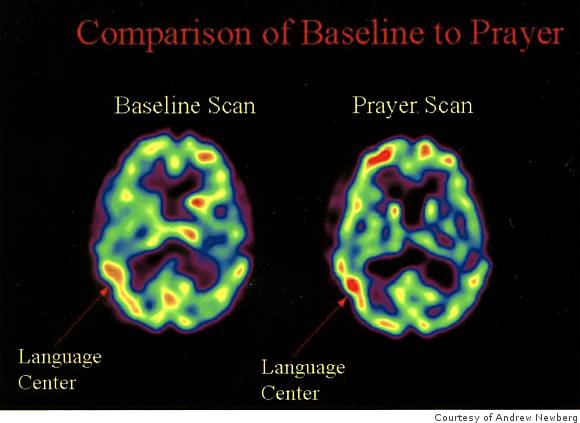
David Ian Miller posts a fascinating interview with Andrew Newberg, a neuroscientist at the University of Pennsylvania and the author of “How God Changes Your Brain” on The San Francisco Chronicle’s website: SFGate.com.
Newberg’s book discusses the results of brain scans conducted on more than 100 people who engaged in meditation and prayer. Writes Miller:
The research shows that the physical and emotional benefits of spiritual observances dramatically accrue over years of practice, but even recent converts exhibit healthier brains — in one study Newburg’s team scanned the brains of people who had never meditated before, then taught them simple meditative methods. After eight weeks of meditating 12 minutes a day, an evaluation showed considerable improvement in memory scores and a measurable decrease in anxiety and anger.
I encourage you to read the entire interview by clicking here. I’ve excerpted the first two questions below:
In your book, you write that religion is a “wonderful tool because it helps the brain perform its primary functions.” Which functions are you talking about, and how does religion help those functions?
The brain has basically two main functions, globally speaking. It helps us to survive, and it helps us to adapt and grow. Religion is extremely valuable in both respects.
A lot of the new research that we’ve been doing shows that when people engage in religious or spiritual activities and practices, or they have religious experiences, by and large they tend to have a positive impact on a person’s mental health and wellbeing. That helps them accomplish their goals, to set a path for themselves, and therefore helps them survive. At the same time, religion and spiritual pursuits help us change and grow over time by giving us a model for transforming ourselves. Ultimately, they’re our way of asking ourselves to follow the ideals of what we think a good human being should be.
You measured the effects of doing a practice like meditation or prayer on the brains of long-term practitioners in different spiritual traditions. What did you notice about the brain of a meditator that’s different from someone who is not meditating?
When we compare the baseline brain scans — meaning when the person is at rest — of long-term practitioners to those of non-practitioners, we see substantial changes in many parts of the brain.
For example, long-term meditators have higher activity in their frontal lobes, the part of the brain that helps us focus our attention and will on whatever behaviors we need to do. Another interesting finding we have noticed occurs in the thalamus, the central structure that helps different parts of the brain communicate with each other and is very involved in processing all of our sensory information. We find there is a difference in how the thalamus is acting in long-term meditators compared to non-meditators. We think this may have something to do with, on the one hand, enabling the brain to function in a heightened way, but it also suggests that it really does alter our way of looking at reality when one engages in these practices. It changes how the brain works.
To continue reading, click here.
* Click here to subscribe to Beyond Blue and click here to follow Therese on Twitter and click here to join Group Beyond Blue, a depression support group. Now stop clicking.

